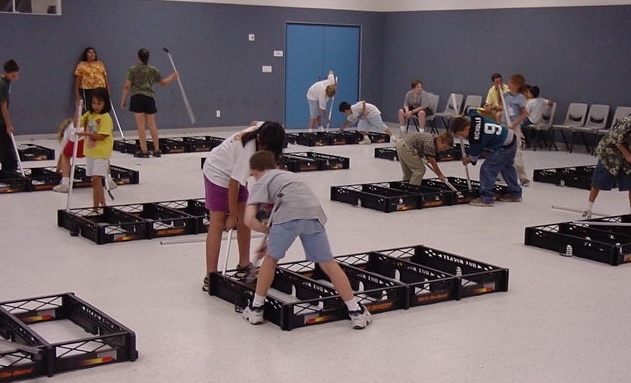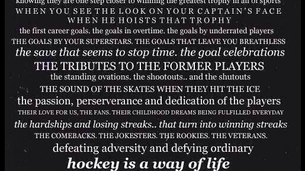BOX HOCKEY
Box Hockey is an active hand game played between two people with sticks, a puck and a five-sided box, and typically played outdoors. The object of the game is to move a hockey puck from the center of the box out through a hole placed at each end of the box, also known as the goal. The two players face one another on either side of the box, and each attempts to move the puck to their left. If a player succeeds in getting the puck to exit the box through the goal, the player scores one point (or goal). The first player to score the predetermined amount of goals wins the game.

MODERN RULES : To start the game (and after each goal), the puck is placed under the center mouse hole. Each player raps the bottom of the box with his hockey stick and then taps his opponent's blade, repeating this three times. After the third tap, both players can go after the puck and play begins. Each player hits the puck with his hockey stick blade, attempting to move the puck through the holes to his left (see diagram) and out the hole at the end of the box (the goal). In addition to advancing the puck towards his own goal, each player can use his blade to block his opponent's progress or to steal the puck. It is legal to use the blade to block the goal from either inside or outside of the box. When a player succeeds in getting the puck to exit the box through the goal, the player scores one point. The first player to score 11 points wins the game.
TRADITIONAL RULES : Each player stands on opposite sides of the box. Your goal is to the right as you face the box, and your opponent's goal is to the left. To start, and after each goal, the puck placed flat, centered, on top of middle wall for the face off. Each player taps the bottom of their side of the box with their stick and then raises it to tap their opponent's stick directly above the puck in rhythm, repeating this three times. After the third tap, both players try to knock the puck off the wall. Each player takes turns with two hits, and whichever side of the center wall the puck lands on determines who goes first. The player with the furthest distance to score goes first. Each player hits the puck with their stick, moving the puck through the holes to their left (see diagram) and through goal. To score you must getting the puck completely through your opponent's goal. Interfering with your opponent is not allowed. The dragging or carrying of the puck is not allowed. Pinning the puck in the corner is allowed. The first player to score 3 goals wins the game.

HISTORY
Box Hockey has little known origin, but the game has been around since at least the late 19th century, as described in various game books, such as Games for the Playground, Home, School and Gym (Jessie H. Bancroft, 1913) and 400 Games for School, Home, and Playground (F.A. Owen Pub. Co., 1920).
Box Hockey was listed as the "Game of the Month" as published in the 1914 Volume 2 of the "Recreational helps" by the New York State College of Agriculture Department of Rural Sociology with the following description: "Box Hockey is an excellent active game for picnics camps and playgrounds. It can also be adapted to indoor recreation if the floor upon which it is played is well padded with old rugs to prevent being damaged with the Hockey sticks.

Around 1937, Milton Bradley sold a box Hockey game (model No. 4125)] By the late 1930s and into the 1940s, it was not uncommon for towns to host youth box Hockey tournaments, such as in Reading, Pennsylvania, where the winners of the Essick Playground and Oakbrook were reported by the local newspaper in the July 11, 1939, July 4, 1941 and June 29, 1949 issues of the Reading Eagle. In the mid-1950s, Larry Best, Director of Recreation for the Milton Hershey School for Boys in Hershey, PA, (the Milton Hershey School was established in 1909 by Milton S. Hershey), in search of an activity that would be healthy, active and fun for the students, became aware of the game, Box Hockey and introduced it to the students as part of their summer recreation program. Individual play as well as school tournaments were promoted and Box Hockey is still an active program at the school with almost 75 student homes (approx 16 students per home) each having a game set today.
In 1994, Andy Brody founded Box Hockey International and started to market and mass produce the larger floor version. This variant of the game features multiple walls with staggered "house holes" through which the puck must be passed to reach either goal. Today, many children play the larger floor version in summer camps throughout the upper part of North America. Box Hockey is also used for agility training in Hockey schools and camps throughout Canada and the U.S
Basic Homemade Antique Instructions : Take two pieces of lumber 2 inches by 10 inches by 8 or 10 feet, and two pieces 1 inches by 10 inches by 4 foot and construct a rectangular box fastening it together with spike nails or wagon bed rods. Take another board 2 inches by 10 inches by 4 feet and nail it into the rectangular frame dividing it into two equal compartments. On the bottom side of the box, cut a hole 3½ inches at the base and about 2½ inches high in the center of each of the end boards, and cut two such holes in the bottom of the dividing board, which make the two equal compartments. These last two holes should be equidistant from the sides of the box. Now get a couple of three foot sticks and an old baseball and you are ready to play. Almost any kind of a stick will do. Saplings cut off underneath the ground so as to get the curve are very good. Also cheap commercial Hockey sticks with the blade mostly cut off are good.


















